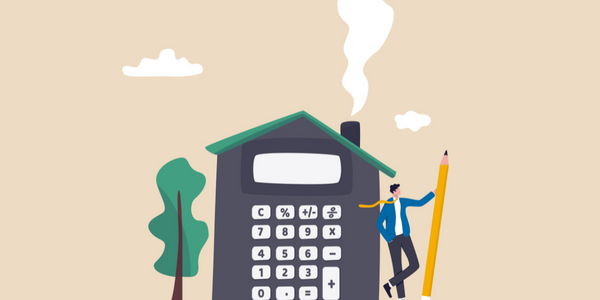
There’s no better time than now to start preparing for homeownership. If your financial goals include things like saving for retirement, paying off student loan debt, or buying a home, this article provides some solid financial planning advice that will get you headed in the right direction.
As an additional resource, you can also download our personal budgeting guide here. When you have a solid plan and set a budget for homeownership, you may find that you’re able to buy a home more quickly than expected.

Tip #1: Get a Clear Picture of Your Finances
This is the starting point for first-time homebuyers, or any buyer for that matter, who are budgeting for homeownership. If you don’t know what you’re spending your money on, executing any budget and reaching your financial goals can be hard. There are a lot of numbers to consider here, including the amount in your savings account, any balances on your credit card, your credit score, and whether you have an emergency fund.
To begin, use an online budgeting tool or a simple spreadsheet. Be sure to write down where every dollar goes as you work to save money for buying a home. Here are a few good options to try:
- YNAB: An app that helps you “give every dollar a job.”
- Empower Personal Wealth: A wealth management tool for tracking your accounts.
- Goodbudget: A digital “envelope system” to help you craft a budget.
- Honeydue: A system for couples to stay on top of their money together.
Most budgeting apps allow you to categorize your expenses. Take advantage of this feature to see exactly where your money is going. Common categories include housing, utilities, groceries, entertainment, and transportation.
If your app has goal-tracking features, use them to monitor your progress toward your long-term financial goals. This can provide motivation and keep you focused on homeownership.
Tip #2: Reduce Your Monthly Spending
This is everyone’s least favorite activity, but it’s probably the most important part of budgeting for homeownership. Evaluate all your expenses and see where you can get rid of extras.
Do you spend a lot of money eating in restaurants or buying expensive coffee drinks? Cooking at home is almost always healthier and less expensive. Plan your meals in advance and create a grocery list to help you avoid impulse purchases and reduce the frequency of eating out.
Or perhaps you could shave off that super-premium cable package—or even eliminate cable altogether and move to a less-expensive streaming service.
Speaking of streaming services, check your credit card and your checking account for other automatic withdrawals. You could be being auto-debited for subscription services you’re not using or didn’t even remember you had. You also want to check your health and car insurance insurance premiums to make sure you’re getting the best rates.
Below are three tools that help manage monthly subscription services:
- Hiatus: A tool to find and organize all your recurring expenses.
- Trim: Helps you find ways to save and manage money.
- PocketGuard: An app that provides insights into all your monthly spending.
If you’ve noticed that you spend a lot of money on impulse purchases such as clothing, gadgets, books, or home decor, some discipline might be in order.
Tip #3: Practice Making a House Payment
When your goals include buying a house, you have to be sure you can afford the monthly mortgage payment.
The first step is to calculate what a home loan payment amount would be. You’ll need to estimate a monthly payment (use our mortgage calculators to help). Be sure to include property taxes, homeowners insurance premiums, private mortgage insurance (PMI), homeowners association fees, and home maintenance.
Take that total amount, subtract your current rent obligation, and put the difference in your savings account each month. This serves two important purposes:
- First, you get used to the house payment before actually paying that amount. This can reduce some of the sticker shock when you purchase a home.
- Second, you will have a ready-made account that is building each month toward the first-year expenses of homeownership. This includes the down payment and closing costs, as well as moving expenses and furniture purchases once you buy your new home.
Unless you know the exact house you want to buy, you’ll need to guesstimate numbers like purchase price, interest rate, property taxes, and HOA fees. Using our mortgage calculators, you can also adjust the purchase price, home loan amount, mortgage loan terms, and mortgage rates to determine how much of a home you can afford.
Tip #4: Set Up Automatic Transfers
An easy way to establish a healthy savings account and save for a down payment is to set up an automatic transfer each month into a specific account earmarked for homeownership. This savings account should be separate from other accounts, with its sole purpose being to help you save money for buying a house.
You can schedule this auto-transfer every paycheck or once a month—whatever works better for your budget. If you have trouble keeping your hands off your current savings account, consider creating this “buy a home” fund at a different banking institution, preferably one that doesn’t make withdrawals too easy.
Tip #5: Build a Strong Credit Profile
When planning to buy a home, one of the first things you need to consider is your credit score. Get a copy of your credit report and go through it meticulously. (You can get a free copy here.)
Take the time to correct any collections or judgments and dispute any errors or inaccuracies. If you need help, you can always reach out to an APM Loan Advisor to help guide you through the process.
Another thing to avoid if you’re looking to build a strong credit profile is late payments on a credit card—or any other bills, for that matter. There’s nothing you can do about mistakes in the past, but make sure you’re paying attention to this moving forward. You’re budgeting for homeownership now, which means setting strong habits for the future.
Want to Work on Your Financial Goals?
Buying a home isn’t complicated, but it requires planning and discipline. A little budgeting here, a credit review there, and a curb in spending can get you where you want to be quickly. (And APM has an interactive budgeting workbook that can help you every step of the way!)
If you’re starting to budget for homeownership, it’s also an excellent time to meet with your APM Loan Advisor to discuss your goals and how we can help you achieve them.
A great next step is to get pre-qualified to see how much home you can afford so you have realistic expectations tied to your homeownership goals.







